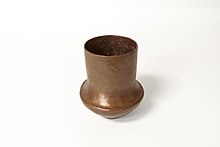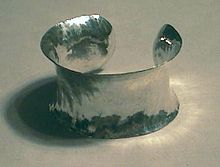

Raising is a metalworking technique whereby sheet metal is formed over a solid object by repeated "courses" of hammering and annealing. A sheet metal worker is often required to raise, or bump, the work into form from the flat metal by means of a raising hammer and raising block. The raising block is made from substance giving resistance to the blows.
A modern term is synclastic raising, the dominant curves of the object being forged are at right angles and move in the same direction; as in a bowl. This results in a surface possessing elliptic geometry.
Anticlastic raising, on the other hand, refers to shaping an object where the dominant axes move in opposite directions; a familiar example of this is a potato crisp. This results in a surface possessing hyperbolic geometry.
See also
References
- Broemel, L. (1918). Sheet metal workers' manual; a complete, practical instruction book on the sheet metal industry, machinery and tools, and related subjects, including the oxy-acetylen welding and cutting process. Chicago: Drake. pp. 134, 215–217.
Bibliography
- Finegold, Rupert and William Seitz. Silversmithing. Krause; 1983. ISBN 0-8019-7232-9
This decorative art–related article is a stub. You can help Misplaced Pages by expanding it. |
This metalworking article is a stub. You can help Misplaced Pages by expanding it. |